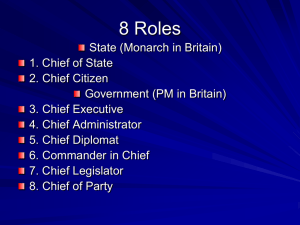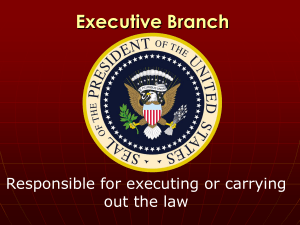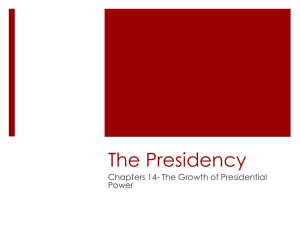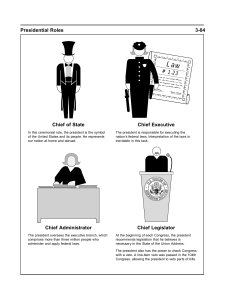Unit 6: Turn Up for the Presidency
advertisement
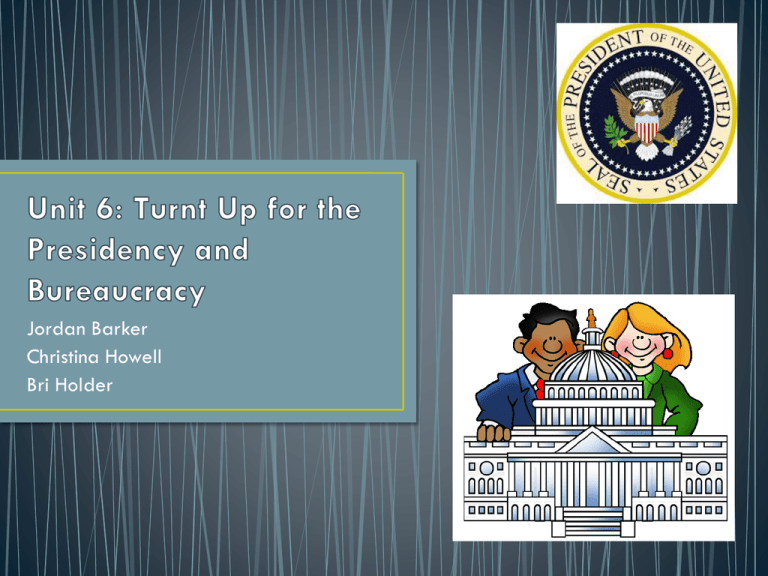
Jordan Barker Christina Howell Bri Holder • Buckley v. Valeo - SCOTUS struck down on ,1st Amendment grounds, several provisions in the Federal Elechon Campaign Act, such as limits on spending. But upheld the provision limiting the size of ind. contributions. • Federal Election Campaign Act – a law passed in 1974 for reforming campaign finances. The act created the Federal Election Commission, provided public financing for presidential primaries and general elections, limited presidential campaign spending, required disclosure, + attempted to limit contributions • United States v. Nixon – the 1974 case in which SCOTUS unanimously held that doctrine of executive privilege was implicit in the constitution but could not be extended to protect docs relevant to criminal prosecutions • Hatch Act – a federal law prohibiting gov’t employees from active participant in partisan politics. • War Powers Resolution – a law, passed in 1973 in reaction to American fighting in Vietnam + Cambodia, requiring pres. to consult w/ Congress whenever possible prior to using military force + to withdraw forces after 60 days unless Congress declares war or grants an extension; Pres. view this uncont. • 22nd Amendment – passed in 1951, the amendment that limits presidents to 2 terms of office. • 25th Amendment – outlines the presidential line of succession, if the VP + cabinet determine the president is incapacitated. First is the VP, followed by Speaker of the House. • Pendleton Civil Service Act – passed in 1883, an Act that created a federal civil service so that hiring + promotion would be based on merit rather than patronage. • Presidential Coattails – these occur when voters cast their ballots for congressional candidates of the president’s party because they support the pres.; few races are won this way. • Pocket Veto – a veto taking place when Congress adjourns w/ in 10 days of submitting a bill to the pres. Who simply lets it die by neither signing nor vetoing it. • Impeachment – the political equivalent of an indictment in criminal law, prescribed by the Const. The HoR may do this to the pres. By a majority vote for “Treason, Bribery, or other High Crimes and misdemeanors.” • Lame-Duck period – period of time in which the presidents terms is about to come to an end. Pres. Typically have less influence around this time period while the people wait for the new leader. • Executive privilege: power of president to refuse to disclose confidential info, U.S. v. Nixon • Executive agreement: a pact between president and a head of a foreign state. They don’t have to be approved by the Senate; aren’t a part of US law and aren’t binding on future presidents. • Line-item veto: the power to veto specific dollar amounts or provisions from major congressional spending bills. Supreme Court struck it down as an unconstitutional expansion of the President’s veto power. • Veto: The constitutional power of the President to send a bill back to Congress with reasons for rejecting it. Two-thirds vote in each house can override veto. • Executive order: regulations originating from the executive branch; are one method presidents can use to control the bureaucracy; more ofter, though, presidents pass along their wishes through their aides • Iron triangle: Entities composed of bureaucratic agencies, interest groups, and congressional committees or subcommittees, which have dominated some areas of domestic policymaking; characterized by mutual dependency, in which each element provides key services, info, or policy for the others • Incentive system: a more effective and efficient policy than commandand-control; in this system, market-like strategies are used to manage public policy • Command-and-control policy: the existing system of regulation whereby government tells business how to reach certain goals, checks that these commands are followed, and punishes offenders • Street-level bureaucrats: A phrase coined by Michael Lipsky, referring to those bureaucrats who are in constant contact with the public and have considerable administrative discretion. • Deregulation: The lifting of restrictions on business, industry, and professional activities for which government rules had been established and that bureaucracies had been created to administer. • Administrative discretion: The authority of administrative actors to select among various responses to a given problem. Discretion is greatest when routines, or standard operating procedures, do not fit the case. • National Security Council: an office created in 1947 to coordinate the President’s foreign and military policy advisors. Its formal members are President, Vice President, Secretary of State, Secretary of Defense, and it is manages by the President’s national security advisor • Independent executive agency: government not accounted for by cabinet departments, independent regulatory agencies, and government corporations; its administration are typically appointed by the President and serve at the President’s pleasure • Independent regulatory agency: government agency responsible for some sector of the economy, making and enforcing rules to protect the public interest; judges disputes over these rules • Standard operating procedures: these procedures are used by bureaucrats to bring uniformity to complex organizations. Uniformity improves fairness and makes personnel interchangeable. • Policy agenda: the list of subjects or problems to which government officials, and people outside of government closely associated with those officials, are paying some serious attention at any given time • Government corporation: government organization, like business corporations, provides a service that could be provided by the private sector and typically changes for its services • Issue network: a network that includes policy experts, media pundits congressional staff members and interest groups who regularly debate an issue • Regulation: The use of governmental authority to control or change some practice in the private sector; pervade the daily lives of people and institutions. • Bureaucracy: a hierarchical authority structure that uses task specialization, operates on the merit principle, and behaves with impersonality; govern modern states • The powers stated in the Article II of the Constitution that are given to the presidents are the powers to create treaties, appoint ambassadors, appoint judges, and appoint officials. • The president has executive powers like, executive privilege, executive agreement, and executive order which bypasses Congress. Executive privilege gives the president the opportunity to avoid legislative and judicial intervention. Executive agreement allows the president to make a temporary agreement with foreign entities which only lasts their term. Executive order allows for legislation to be applied without consent of other branches. • The executive branch is organized into the Cabinet, the White House, and the regulatory agencies. The Cabinet gives expert advice on their respective departments. The White House Staff is specially chosen to help and back the president. The regulatory agencies are governmental agencies that take care of operations that should be in the hands of the government or should be independent from politics all together. This allows for a smooth bureaucratic process that handles most of the application of legislation. • The executive branch is checked by the majority override by Congress and the judicial review. The executive branch has gained a lot of power since the Constitution was created. They have been able to skirt constitutionality and avoid the consent of congress.


